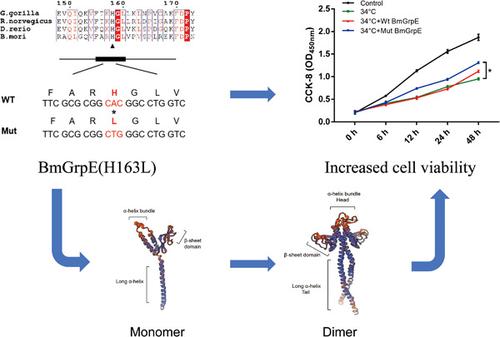当前位置:
X-MOL 学术
›
Arch. Insect Biochem. Physiol.
›
论文详情
Our official English website, www.x-mol.net, welcomes your
feedback! (Note: you will need to create a separate account there.)
Identification of the nucleotide exchange factor BmGrpE and its role under high-temperature stress in silkworm, Bombyx mori.
Archives of Insect Biochemistry and Physiology ( IF 1.5 ) Pub Date : 2020-02-24 , DOI: 10.1002/arch.21664 Jinxin Li 1 , Zhengting Lu 1 , Tingting Mao 1 , Mengxue Li 1 , Hui Wang 1 , Jianwei Qu 1 , Jian Chen 1 , Yilong Fang 1 , Fanchi Li 1, 2 , Bing Li 1, 2
Archives of Insect Biochemistry and Physiology ( IF 1.5 ) Pub Date : 2020-02-24 , DOI: 10.1002/arch.21664 Jinxin Li 1 , Zhengting Lu 1 , Tingting Mao 1 , Mengxue Li 1 , Hui Wang 1 , Jianwei Qu 1 , Jian Chen 1 , Yilong Fang 1 , Fanchi Li 1, 2 , Bing Li 1, 2
Affiliation

|
The high‐temperature stress gene GrpE plays an important role in coping with high‐temperature stress. The mutation of key sites of this gene can improve the high‐temperature resistance of organisms. In the present study, using complementary DNAs from the silkworm fat body as the template, the open reading frame sequence of the GrpE gene (BmGrpE) was amplified and was found to be 644 bp in length and encode a protein with a predicted molecular weight of 24.1 kDa. The presence of a binding site for the heat shock transcription factor (Hsf1) at −1440 bp upstream of its coding region indicates that BmGrpE may respond to high‐temperature stress. BmGrpE was constitutively expressed throughout developmental stages, with the highest level observed in the 5th instar larvae stage. Moreover, in 5th instar larvae (the 3th day), BmGrpE was expressed in all tissues examined, with the highest levels in the fat body, silk gland, and midgut. Interestingly, under high‐temperature stress, TiO2 nanoparticle treatment increased the messenger RNA levels of BmGrpE in the fat body and silk gland. After treatment with dsRNA of BmGrpE, the cell viability of BmN cells was significantly decreased under 34°C and H2O2 stress (p < .05). Mutation of BmGrpE (H163L) enhanced the resistance of BmN cells under high‐temperature stress. These results provide new clues for the study of molecular mechanisms of insect resistance to high temperatures.
中文翻译:

核苷酸交换因子BmGrpE的鉴定及其在家蚕高温胁迫下的作用。
高温胁迫基因GrpE在应对高温胁迫中起着重要作用。该基因关键位点的突变可以提高生物体的耐高温性。在本研究中,以来自家蚕脂肪体的互补DNA为模板,扩增了GrpE基因的开放阅读框序列(BmGrpE),发现其长度为644 bp,并编码一种预测分子量为的蛋白质。 24.1 kDa。在其编码区上游-1440 bp处存在一个热激转录因子(Hsf1)的结合位点,表明BmGrpE可能对高温胁迫作出反应。BmGrpE在整个发育阶段都以组成型表达,在第五龄幼虫阶段观察到最高水平。此外,在第5龄幼虫(第3天)中,BmGrpE在所有检查的组织中都有表达,在脂肪体,丝腺和中肠中含量最高。有趣的是,在高温胁迫下,TiO 2纳米颗粒处理增加了脂肪体和丝腺中BmGrpE的信使RNA水平。用BmGrpE的dsRNA处理后,在34°C和H 2 O 2胁迫下,BmN细胞的细胞活力显着降低(p <.05)。BmGrpE突变(H163L)增强了BmN细胞在高温胁迫下的抗性。这些结果为研究昆虫抗高温分子机制提供了新的线索。
更新日期:2020-02-24
中文翻译:

核苷酸交换因子BmGrpE的鉴定及其在家蚕高温胁迫下的作用。
高温胁迫基因GrpE在应对高温胁迫中起着重要作用。该基因关键位点的突变可以提高生物体的耐高温性。在本研究中,以来自家蚕脂肪体的互补DNA为模板,扩增了GrpE基因的开放阅读框序列(BmGrpE),发现其长度为644 bp,并编码一种预测分子量为的蛋白质。 24.1 kDa。在其编码区上游-1440 bp处存在一个热激转录因子(Hsf1)的结合位点,表明BmGrpE可能对高温胁迫作出反应。BmGrpE在整个发育阶段都以组成型表达,在第五龄幼虫阶段观察到最高水平。此外,在第5龄幼虫(第3天)中,BmGrpE在所有检查的组织中都有表达,在脂肪体,丝腺和中肠中含量最高。有趣的是,在高温胁迫下,TiO 2纳米颗粒处理增加了脂肪体和丝腺中BmGrpE的信使RNA水平。用BmGrpE的dsRNA处理后,在34°C和H 2 O 2胁迫下,BmN细胞的细胞活力显着降低(p <.05)。BmGrpE突变(H163L)增强了BmN细胞在高温胁迫下的抗性。这些结果为研究昆虫抗高温分子机制提供了新的线索。











































 京公网安备 11010802027423号
京公网安备 11010802027423号